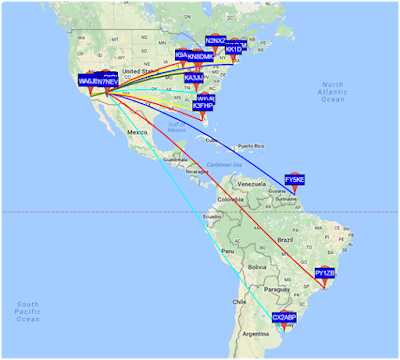The sun has been active after the Fall Equinox. Not a lot of sunspots, but lots of geomagnetic activity.
A and K Indices have been elevated for a couple of weeks. The result is some nice propagation on 10 Meters at times. October usually is a good month in years of high solar activity. It looks like it won't disappoint us.
All of the following maps are 24 hour captures on 10-Meter WSPR.
09/26/2016
09/28/2016
09/29/2016
10/04/2016

10/12/2016 Nice opening to Australia and New Zealand.

09/29/2016
10/02/2016
10/03/201610/04/2016
10/05/2016
I took a few days off.
10/12/2016 Nice opening to Australia and New Zealand.
10/13/2016 Despite a G1-G2 Geomagnetic Storm.

11/01/2016
I have been off for a few days. Despite low solar activity, it is still open.

11/04/2016

11/23/2016
The Sun has been quiet for the remainder of November. There has been a couple of days with activity, but overall DX has been limited. Today the first good Fall/Winter opening on 10-Meters occurred. For about 6 hours there was occasional paths in all directions. I strongly believe that meteor showers are an influence. It isn't a meteor that causes it, but residual ionization left by them that stirs up the Es layer.
I have replaced the desktop computer running WSPR and have had issues with the rig interface. Meanwhile in order to utilize the computer, I have switched back to PropNET (PSK31 Realtime Propagation Reporting).

7 Days.
12/16-23/2016
F2 opportunities were nil as solar activity was very low. I would call this propagation chordal interaction of the E and F layers. Openings were short in duration, but pretty good when it opened up. They occurred usually late morning, mid-day and late afternoon.
I noticed that some of these openings occurred just prior to a geomagnetic disturbance. Despite low sunspot numbers, several large coronal holes continue to produce streams to later disturb the ionosphere. Trans-Equatorial propagation is a usual result.
As I have said many times...
Don't give up on this band.
73 Art KA5DWI/7
I have been off for a few days. Despite low solar activity, it is still open.

11/04/2016
I am always amazed how the band changes day to day. Yesterday, VK, ZL & an E5 filled the waterfall during the afternoon.

11/23/2016
The Sun has been quiet for the remainder of November. There has been a couple of days with activity, but overall DX has been limited. Today the first good Fall/Winter opening on 10-Meters occurred. For about 6 hours there was occasional paths in all directions. I strongly believe that meteor showers are an influence. It isn't a meteor that causes it, but residual ionization left by them that stirs up the Es layer.
I have replaced the desktop computer running WSPR and have had issues with the rig interface. Meanwhile in order to utilize the computer, I have switched back to PropNET (PSK31 Realtime Propagation Reporting).
5 Days
12/05-09/2016
7 Days.
12/16-23/2016
F2 opportunities were nil as solar activity was very low. I would call this propagation chordal interaction of the E and F layers. Openings were short in duration, but pretty good when it opened up. They occurred usually late morning, mid-day and late afternoon.
I noticed that some of these openings occurred just prior to a geomagnetic disturbance. Despite low sunspot numbers, several large coronal holes continue to produce streams to later disturb the ionosphere. Trans-Equatorial propagation is a usual result.
As I have said many times...
Don't give up on this band.
73 Art KA5DWI/7









No comments:
Post a Comment